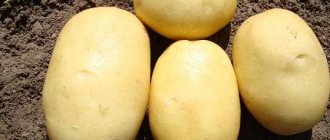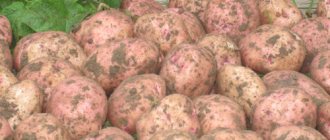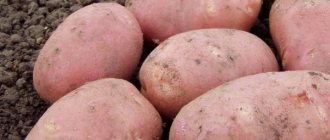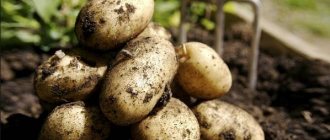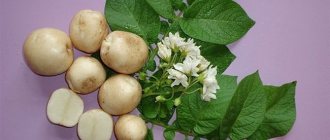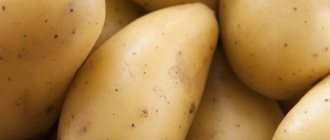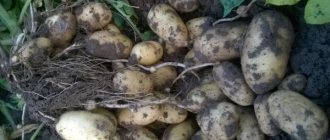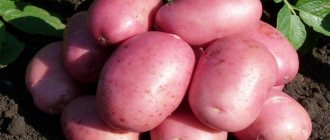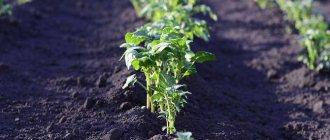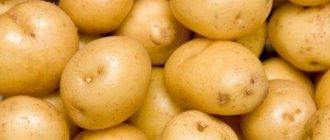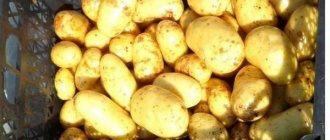Origin story
Holland is famous for its potato cultivation technology and its excellent varieties. From this country they are exported all over the world. This is how the Picasso variety once came to us. It was created by the company AGRICO UA. Externally, the tubers resemble an artist’s palette: the unusual combination of light crimson and yellowish colors on each of them gives them originality. Since 1995, the time when it was included in the State Register of Breeding Achievements, potatoes have been cultivated in the central region of Russia. More than 20 years of folk selection and selection gave rise to local clones. This is exactly how the Ivan da Marya potato appeared. The unusual appearance gave rise to many names: Little Red Riding Hood, Gorbachevka, Matryoshka. Here he is in the photo.
Description and characteristics
Ivan da Marya potatoes ripen at a late date. For a full growing season of this variety, it takes from 110 to 130 days, depending on the weather. Tuberization in Ivan da Marya is high: each bush can produce up to twenty tubers with an average weight of about 120 grams. We are also pleased with the high marketability of the resulting harvest - more than 90%. Ivan da Marya potatoes are suitable for growing in the Central Black Earth and Central regions. Each of them has different yields. If in the Central region you can collect up to 320 kg per hundred square meters, then in the Central Black Earth - only 190 kilograms from the same area.
The potatoes are not too starchy. Depending on the growing conditions, the starch content in tubers ranges from 7.9% to 13.5%. Therefore, the taste can be satisfactory or good. But the tubers of Ivan and Marya are stored well. About 90% of the harvested crop lasts until spring without damage.
The Ivan da Marya potato bush is tall with straight stems and well leafy. It blooms with creamy white flowers that quickly fall off without forming berries.
The tubers of the Ivan-da-Marya potato are notable for their multi-colored colors. Pink spots and small eyes of the same color stand out brightly against a yellow background. The inside of the flesh is creamy in color.
The production of seed tubers from this Dutchman has been mastered by many Russian seed farms. It can be bought at ZAO Oktyabrskoye in the Leningrad Region, at LLC Meristemnye Kultury in the Stavropol Territory, at Agro and at the All-Russian Research Institute of Potato Farming named after. Lorja.
Peculiarities
Interestingly, very often the name of this potato depends on where it grows. Common. In the Stavropol region it is called Ryabukha, and in Kirov - Lis” or, derived from it, Lyska.
The unusual appearance is complemented by a number of other features:
- high productivity;
- boils well during heat treatment;
- each plant produces a lot of fruits;
- very good shelf life, therefore, potato sales are high;
- average or late landing time;
- prefers acidified soil type;
- has stable immunity to A, Yn viruses.
The stems of the bush are tall, straight, have a large number of leaves, and can be inclined to the ground. The leaves are very large, rich green. The buds are most often white, sometimes cream. The plant blooms profusely; at the budding stage, all the inflorescences fall off.
Please note! The tubers are streamlined, round-oval in shape, thin skin, unusual beige, bright burgundy color, which will interest buyers. The eyes are small, pale pink. The starch concentration in the fruit is average, from 8 to 14%
Ivan da Marya belongs to the group of high-yielding species, so it is possible to collect a lot of fruits from each bush, about 15–25
The starch concentration in the fruit is average, from 8 to 14%. Ivan da Marya belongs to the group of high-yielding species, so it is possible to collect a lot of fruits from each bush, about 15–25.
The ripening time after the first shoots is 110–120 days. The average fruit weight is about 90–120 grams. Size varies due to different climatic conditions, frequency of fertilizing and watering. The pulp is tender, cream-colored. The shelf life of potato tubers is high - 90%, marketability - more than 93%, which cannot but please sellers.
Advantages and disadvantages
Like any other variety, Ivan da Marya has its own advantages and disadvantages. They can be summarized in a table.
| Advantages | Flaws |
| High yield, large tubers | Quickly loses varietal characteristics |
| Good taste | Moderate resistance to leaf curl and late blight |
| Universal application | Scab infection |
| High marketability | Weakly resistant to late blight |
| Good keeping quality | |
| Resistance to cancer and potato nematode | |
| Poor formation of berries - all the forces of the bush are aimed at forming a harvest |
Advice! The varietal characteristics of any potato can be improved by annually selecting tubers from the most productive bushes. They must be fully consistent with the variety.
Landing
Only properly planted potatoes will give a full harvest. There are many different planting methods. Let's stick to the traditional. Before planting potatoes, the tubers need to be germinated.
Germination
Important! Since Ivan da Marya potatoes are late-ripening and are also affected by late blight, germination is mandatory for them. In this case, the growing season will be shortened.
It will take about a month for Ivan da Marya potato tubers to form strong sprouts. Conditions for germination:
- lay out the tubers in one or two layers in the light;
- We maintain the temperature at about 20 degrees for about 10 days, during which time the sleeping eyes will wake up;
- during the remaining 20 days we maintain the temperature no higher than 15 degrees;
- During this time, the tubers need to be turned over several times so that they form sprouts evenly.
Advice! If during germination the potatoes are sprayed a couple of times with a weak solution of mineral fertilizer, the harvest will be greater.
You can watch the video for more information about sprouting potatoes:
Landing dates
This is a very important point. Potatoes planted too early will chill and take a long time to germinate, and may even rot completely. If you are late with planting, the soil will dry out and there simply won’t be enough moisture. All this will significantly reduce the yield. Even our ancestors began to plant potatoes when their bare feet on the ground were not cold. If we translate this rule into modern language, the soil temperature at a depth of half a shovel bayonet should be about 10 degrees Celsius. Usually this moment coincides with the appearance of leaves on the birch tree and the beginning of bird cherry flowering.
Landing rules
It would seem that everything is simple: put the potatoes in a hole and cover them with earth. But there are some subtleties here too:
- the distance between the rows for late varieties, namely the Ivan da Marya potatoes, should be about 70 cm;
- the distance between tubers in a row is from 30 to 35 cm;
- For better lighting, the rows are arranged from north to south.
Advice! If you want larger tubers, don't plant potatoes too often. It simply does not have enough power supply area.
Tubers the size of a chicken egg are best suited for planting. You can plant smaller ones, but then more often. Planting holes are filled with humus or compost - about 1 liter, ash - about a tablespoon and a teaspoon of complex mineral fertilizer with microelements. It would be better if it was specifically designed for potatoes.
Advice! First put potatoes into the hole, and then humus, ash and fertilizer.
The roots of the plant are located above the tuber. If food is placed at the bottom of the hole, it will be difficult for growing potatoes to use it.
All that remains is to fill the holes with soil.
You can watch the video about different methods of planting potatoes:
Care
To get a good potato harvest, you have to work hard. Planting tubers and forgetting about it before harvesting will not work. At best, you can collect a handful of potatoes the size of a pea. All agrotechnical measures for caring for plants must be carried out on time and in full:
- weed and loosen, preferably after each rain or watering;
- water in dry weather. The Ivan da Marya potato is especially demanding of moisture at the tuberization stage.
- It will be necessary to carry out hilling and root and foliar feeding in a timely manner;
- You will also need to take care of protecting Ivan da Marya potatoes from diseases and pests.
Important! Diseases and pests significantly shorten the growing season of plants, reducing the yield.
Hilling and feeding
Gardeners often argue about whether they need to hill up potatoes. Traditional technology considers this operation mandatory.
Hilling
What are the advantages of hilling:
- The soil retains moisture better.
- The tubers are not exposed and do not become green.
- The air regime of the soil improves.
- In hot weather, the soil does not overheat and the tubers do not bake in it.
- The overall harvest increases.
Important! If the potatoes are not hilled, the number of tubers will be smaller, but their mass will be greater.
According to classical technology, hilling is carried out twice: the first - when the sprouts reach a height of about 14 cm, the second - after two to three weeks, usually this coincides with the flowering of the potatoes.
In those regions where return frosts are repeated with enviable consistency, you should not wait until the potatoes grow to the required size. It is better to hill up the seedlings as soon as they appear: this will protect them from freezing.
Often another hilling may be necessary if young tubers are on the surface of the soil. When carrying out this procedure it is important:
- do it early in the morning or late in the evening;
- after rain or watering.
Warning! If you hill up potatoes with dry soil, new stolons will not form, since moisture will not reach the roots well.
Hilling must be carried out very carefully, raking soil from the row spaces.
Top dressing
Potatoes take a lot of nutrients out of the soil. To make the harvest happy, you will need 3 root feedings.
- A month after planting, 10 g of urea and potassium sulfate and 20 g of superphosphate are dissolved in a bucket of water. This amount is enough to feed one square meter of plantings. You can apply dry fertilizers between the rows, but then you will need good watering. Even at the first stage of growth, you cannot overdo it with nitrogen fertilizers; the tops will be very good, and few tubers will be formed.
- The second feeding is carried out in the budding phase.
- The third - at the end of flowering.
Foliar feeding will also be required. If plant development is slow, they can be fed with a weak urea solution - 10 g per bucket. During budding, it will be useful to spray with a solution of complete mineral fertilizer with microelements - 15 g per bucket.
To ensure that there are no voids in large Ivan-da-Marya potato tubers and that the taste improves, during tuberization, foliar fertilization is carried out with a solution of Mag-Bor fertilizer - a tablespoon per bucket of water.
Foliar fertilizing with phosphorus gives a very good effect during tuber ripening. For it you need to dissolve 20 grams of superphosphate in 10 liters of water. You need to infuse the solution for two days, remembering to stir. For spraying, a liter of solution per hundred square meters is enough.
Description of potato variety Ivan da Marya, planting rules and care
In the modern world, many types of potatoes have been developed by crossing different varieties. As a rule, hybrid vegetable crops are expected to have unique characteristics that reduce the cost of growing and caring for them. And the more modern potato selection is, the more resilient and unpretentious this crop becomes.
The Ivan da Marya potato, a description of the variety of which you will read below, is not a new development, but the vegetable, proven over the years, has high yields, a unique appearance and excellent taste characteristics.
Descriptions of crops
The ripening period of vegetable crops is late, from 120 to 150 days from the moment of planting in open ground. The bushes are straight, tall with slight branching and abundant, large, green foliage.
During the flowering period, inflorescences appear, which open with white or cream flowers. The rhizomes of the plants are powerful; from 12 to 25 large root crops ripen under each bush.
Tubers are smooth, from 70 to 160 g, with smooth skin and spots of yellow-red shades, starch content 8-13%.
History of selection
The potato variety Ivan da Marya, like the variety Ivan da Shura, was created by amateur breeders in the mid-80s of the last century. The varieties of Scottish and Dutch potatoes were taken as a basis.
The result was a very unusual new variety, Ivan da Marya, both in external characteristics and in taste.
Currently, the variety is rarely planted on an industrial scale, but is actively grown by gardeners and gardeners.
Key Similarities and Differences
The main difference between potato varieties is the timing of ripening and harvesting. If the Ivan da Shura potato is ready for harvesting within 70-75 days after planting in open ground, then the Ivan da Marya variety will require about 4 months for the crop to fully ripen. Otherwise, potatoes of these varieties are not inferior to each other.
Comparative characteristics of Ivan da Marya and Ivan da Shura
Each type of vegetable crop has distinctive characteristics due to which it is in demand and gains fame.
Main features and characteristics of Ivan da Marya:
- Planting material quickly degenerates, so potatoes of this variety must be constantly bred.
- Excellent taste allows you to use potatoes for preparing any dishes.
- The variety is universal; it is planted both industrially and in garden plots and vegetable gardens.
- The variety is resistant to nematodes and cancer.
- Long-term storage of ripened root crops and the possibility of long-distance transportation.
- Does not require maintenance.
Main characteristics of Ivan da Shura.
- High taste characteristics.
- Early ripening of root crops.
- Possibility of long-term storage.
- Resistant to drought and high temperatures.
- With proper care, the variety produces a large harvest.
- Natural immunity to most diseases.
Based on the comparative characteristics, it becomes clear that the varieties Ivan da Marya and Ivan da Shura practically do not differ from each other, with the exception of the timing of ripening of root crops.
Which is better: key advantages and disadvantages
Although potato varieties are not included in the state register, they are popular among farmers and gardeners. Like any vegetable crop, these potato varieties have their advantages and disadvantages. Both varieties do not require special agrotechnical care rules. But Ivan da Shura loves moderate moisture and feeding, and easily tolerates drought.
Ivan da Marya requires careful compliance with irrigation work, especially in the absence of precipitation and extreme heat.
https://www.youtube.com/watch?v=MQsFAqH6qwk
Without sufficient soil moisture, plants wither and stop developing, which negatively affects the harvest.
Also, the Ivan da Marya variety is considered more susceptible to some diseases and pests. And the main difference between varieties is the timing of harvest ripening. If you have not yet become acquainted with these types of vegetable crops, then try planting both varieties, and based on the harvest results, choose the one you like best.
Technology of planting and caring for varieties
The main requirement for vegetable crops is their productivity. And without proper planting and agricultural practices, it is impossible to get a good harvest. Therefore, in order to grow potatoes you will have to follow certain rules.
Timing of work
The timing of the start of planting depends on the weather conditions of the region where the potatoes grow. In the south, work is carried out already in April, in the central region at the beginning of May, in northern latitudes, as soon as the soil warms up to 8-10 degrees.
Preparing the site and tubers
Potatoes are planted in open, well-ventilated and illuminated areas. Soil preparation begins in the fall. The land plot intended for planting vegetables is dug up to a depth of 3-40 cm from the soil surface and mixed with humus. Next, the soil is thoroughly loosened and left until spring.
In the spring, the beds are dug up again, the soil is mixed with organic fertilizers. Tubers for planting in open ground are prepared in advance. Planting material is selected from past harvests or purchased from nurseries. Planting material is carefully inspected for severe damage and signs of mold and rot. Spoiled tubers are thrown away.
15-20 days before planting, potatoes are sent to germinate in a warm and bright place. If the tubers dry out too much during germination, they are sprayed with a humidifier.
As soon as sprouts of 1 to 3 cm appear, the planting material is ready for planting in open ground. Before planting, it is advisable to treat the tubers with antibacterial agents.
In this case, the plants’ immunity to various diseases increases.
Important! Each root crop must have at least 5-7 shoots. If the root crop is cut for planting, then each part should have 2-3 sprouts.
Planting methods
The usual method of planting potatoes is to place the prepared, sprouted tubers in dug holes or a harrow, 10-12 cm deep. The distance between the holes is at least 30-35 cm, between the beds from 60 to 80 cm. The planting material is deepened by 5-8 cm and sprinkled with earth. There are also other ways to plant potatoes.
By no-till planting
The potatoes are laid out on the ground at a distance of 25-35 cm between tubers and 60-70 cm between the intended beds. Next, a trench is dug between the beds, and the tubers laid out for planting are covered with this soil. It is desirable that the covering soil be fertile. The resulting ridges must subsequently be loosened and hilled.
By planting under straw
When planting potatoes in open ground, the method of planting tubers under straw is used. Many gardeners and gardeners claim that this method of planting potatoes provides greater yields.
- The soil is thoroughly loosened and all lumps are removed.
- The soil is very moist.
- Sprouted planting material is laid out in holes or harrows.
- The holes are covered with a thick layer of straw.
Important! When planting a vegetable crop under straw, it does not need to be watered or hilled.
Watering
The varieties Ivan da Marya and Ivan da Shura do not require special watering conditions. If Ivan da Shura is drought-resistant, then Ivan da Marya has difficulty withstanding a lack of moisture during a drought. On average, potatoes are thoroughly watered 3 times throughout the entire season. Irrigation work is especially important when plants are flowering.
Loosening and hilling
Loosening the soil is usually timed to coincide with watering and fertilizing. Loosening removes weeds and retains moisture in the soil. Hilling up potato beds is carried out several times during the entire growth period.
For the first time, the beds with young shoots that have just emerged from the ground are earthed up.
The next hilling occurs during the potato flowering period. The last time work is carried out is after the plants have faded. Hilling up potatoes is carried out in well-moistened soil. Thus, the root system of the plant is enriched with oxygen and moisturized.
Fertilizing: what and when to feed the plantings
For a good and abundant harvest, the vegetable crop is fed and fertilized. 25-30 days after planting in open ground, potatoes are fed with potassium and phosphate fertilizers. Next, the potatoes are fed during the formation of buds and after flowering.
Protection from diseases and insects
If planting measures are carried out correctly, then diseases and pests are not dangerous for these potato varieties.
And in order to avoid the risk of infection with viral and fungal diseases, planting material is replaced every 3-4 years.
If the Ivan da Shura variety has natural immunity to diseases and pests, then Ivan da Marya often encounters late blight. In this case, the plants are treated with professional preparations containing copper.
Important! Proper and timely care of potatoes will help minimize the risk of plant disease.
Harvesting nuances
The ripening periods for varieties are different, but the process of harvesting and storing the crop is no different. As soon as the tops begin to dry out and wither, it means the root crops are ripe. 7-10 days before the start of harvesting work, the tops are cut off.
Digging potatoes with a pitchfork, thus reducing the possibility of technical damage to the tubers.
Next, the root vegetables are dried for 10-14 days, and only then they are packed into bags or boxes and sent for storage in a cool, well-ventilated place.
Reviews from vegetable growers about varieties
Inga Sergeevna, Moscow region
The first time I saw and tried Ivan da Marya potatoes was at my neighbor’s house. She shared the seeds with me, and for 3 years now the whole family has been collecting this multi-colored miracle. The only drawback is that these potatoes are loved by various pests, but we can cope.
Svetlana Pavlovna, Ulyanovsk
We have been familiar with the Ivan da Marya variety for many years and have no plans to change the variety. We constantly update the seed material, we have learned how to care for the variety, all sorts of bugs love it and it requires treatment against late blight. But this doesn’t scare me, because the potatoes are very tasty.
Nikolay, Perm
I am very pleased with the Ivan da Shura variety. Beautiful, even tubers, early ripening and unusual taste. What else do you need for good potatoes?
- Ask a Question
- Choose a tomato variety
- Choose a variety of cucumbers
- Lunar calendar 2020
Source: https://MoeFermerstvo.ru/kartofel/69-ivan-da-marya
Diseases and pests
Viral and fungal diseases cause the most damage to potatoes.
Viral diseases
There are many viruses that infect potatoes. They can significantly reduce the yield, depending on the pathogen - from 10 to 80% of the potatoes are lost. When planting potatoes obtained from seeds - super super elite and super elite, they are free from viruses. Infection occurs with the help of pests. Over time, viruses accumulate and so-called potato degeneration occurs.
Important! That is why the seed needs to be changed every 3-4 years.
Virus damage is indicated by various spots, stripes or wrinkling of the leaves. There is no means to combat viruses on potatoes. It is necessary to carry out biological cleaning by inspecting the bushes. All suspicious ones are dug up and the tops are burned.
Fungal diseases
All gardeners know about late blight and diligently fight it by processing tomatoes. But potatoes need no less treatment, since the outbreak of the disease begins with them. It can affect all parts of the plant, manifesting itself as vague, wet spots on the leaves, from the inside of which a white coating of spores is visible. Brown, hard spots appear on the tubers. Ivan da Marya potatoes are not resistant to late blight. Therefore, mandatory treatments with copper-containing preparations or phytosporin are required. They begin from the moment of budding and end no later than 10 days before harvesting. The total number of treatments is up to 5.
A dangerous disease is potato cancer. The fungus that causes it can live in the soil for up to 20 years.
Warning! For planting, choose only cancer-resistant potato varieties, which include Ivan da Marya.
Potatoes may be affected by Phoma, black and common scab, and ring rot. To prevent them, it is necessary to observe crop rotation, not apply fresh manure, keep the plantings free of weeds and hill up the plants on time.
Pests
Potatoes have a lot of people who want to eat them.
- The most annoying thing about potatoes is the Colorado potato beetle. Its larvae can completely eat all the leaves, leaving the gardener without a harvest. They are fought with the help of chemical methods and folk remedies. You can collect pests by hand. Do not remove ants from the garden; Colorado potato beetles do not live near an anthill.
- Tubers are also damaged by wireworms—the larvae of the click beetle. The drug Prestige is used against them. Repeated loosening of the soil, as well as liming, also helps.
- Nematodes, of which golden nematodes are the most harmful, can reduce crop yields by 80%. They are considered quarantine pests and are very difficult to control. It is easiest to plant nematode-resistant varieties, and the Ivan da Marya potato is highly resistant to this pest.
Important! Even nematode-resistant varieties need to update planting material every four years.
How to harvest and store crops
The potato harvest occurs in the second half of September. It is carried out in warm weather without rain, so that the root crops removed from the ground dry in the air. The collection procedure takes no more than 3 hours. The potatoes are sent to the storage room for 1.5-2 weeks. This is preparation before storage. During this time, the skin of the fruit becomes rough, mechanical damage will disappear.
Important! Before sending the resulting harvest for storage, it is carefully inspected, identifying diseased and unsuitable root crops for consumption.
Medium-sized tubers are selected from the entire mass as planting material if planting is planned for the next season. Such tubers should be kept in boxes in a cool room with good ventilation. The best place for storage is a cellar or basement with a constant air temperature of 2-5 °C.
Note! If desired, you can store root crops on the site in pits 1.5 m deep. They need to be covered with straw and an earthen layer 70-80 cm thick. This will protect the potatoes from winter frosts.
Harvesting
Ivan da Marya potatoes are ready for harvesting 4 months after planting. At the end of summer, there is a high probability of plants being affected by late blight. Experienced gardeners advise mowing the tops 2 weeks before digging potatoes. What does it give:
- The likelihood of tubers being affected by late blight is reduced.
- They ripen in the ground.
- The peel becomes denser and is less damaged during harvesting.
- Such potatoes will be stored better.
If there is a need to select part of the collected tubers for planting next year, you need to collect them in the field. To do this, potatoes from each bush are placed next to the dug hole. It should dry out a little: on a sunny day - no longer than 2 hours, and on a cloudy day - about 4.
During this time, the required number of tubers is selected, observing the following conditions:
- the shape and color of the tubers must fully correspond to the variety;
- they need to be selected only from bushes that contain at least 15 potatoes;
- The size of the tuber is about the size of a chicken egg.
Potatoes are not stored immediately after digging. It should lie in piles in a barn or any other suitable room for at least 2 weeks. After this, the tubers are sorted and sent for long-term storage.
Reviews about the variety
Reviews about the variety vary.
Some say that the only advantage is its pleasant taste. Constantly suffers from scab and late blight, the harvest is small - tubers are 1-2 cm long. The tops are really beautiful and tall.
Others say that Gorbachevka is a classic! They have been growing them in the country for ten years in a row without any degeneration. Water once a week. For beetles they are sprayed 2 times during the summer. Before planting, chicken manure is added. From 2 acres to 30-40 buckets. Very tasty potatoes.
The most productive potato varieties:
